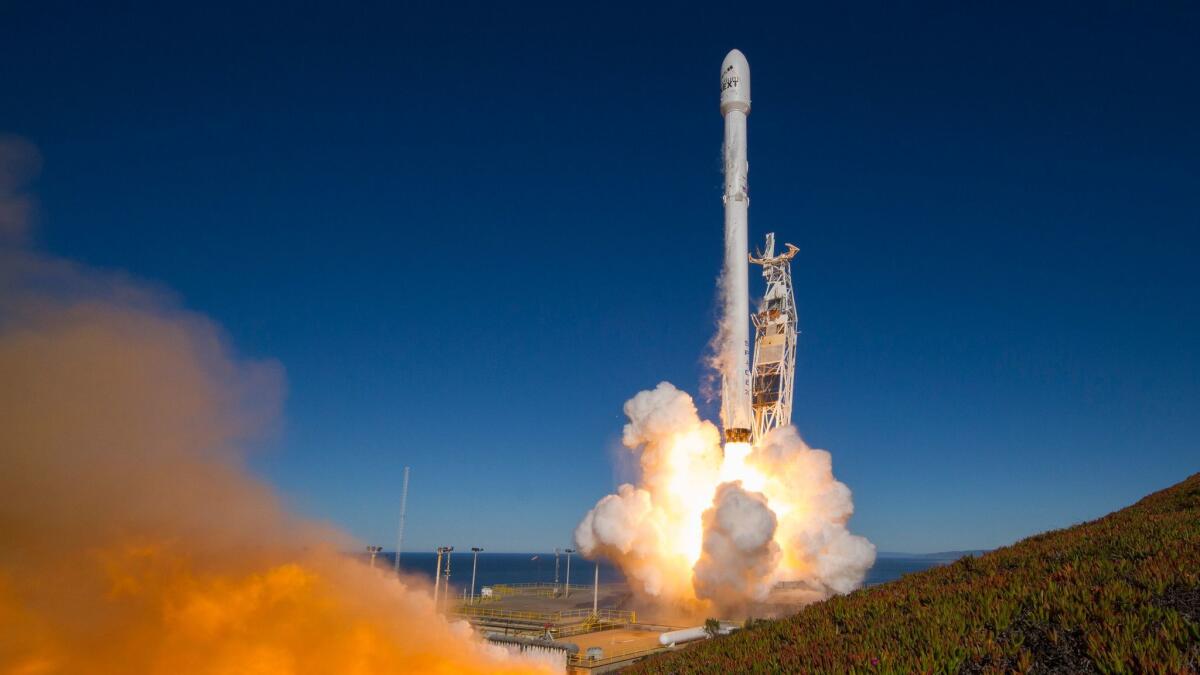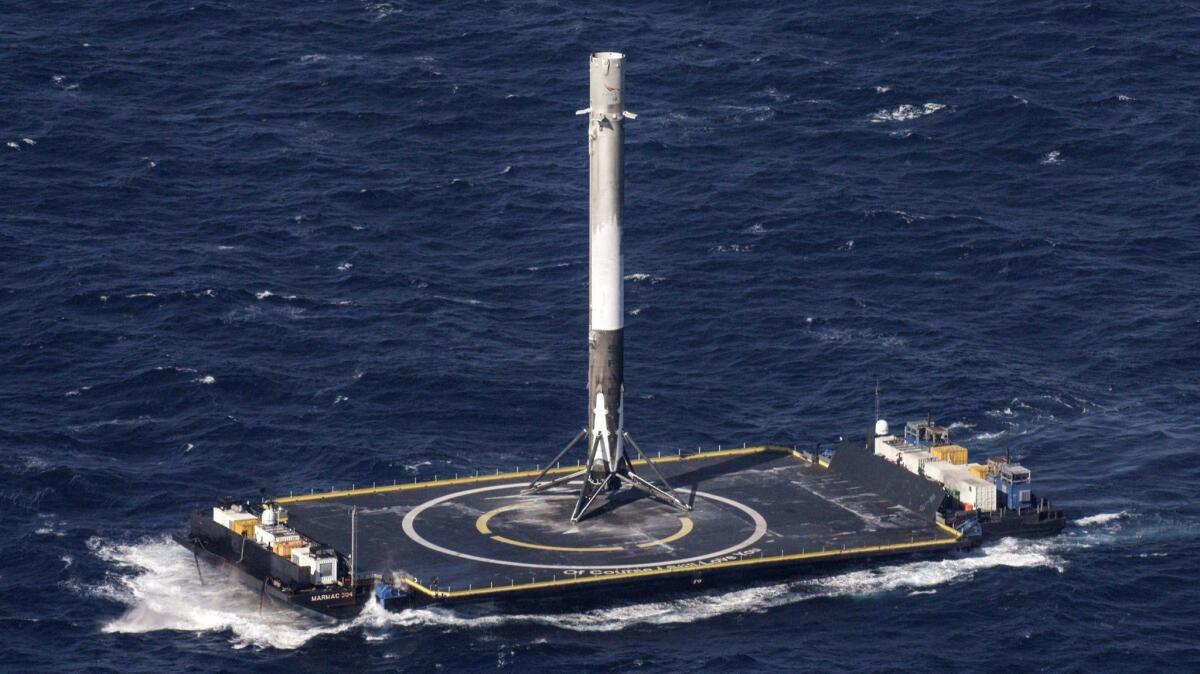From its Falcon Heavy to reusing its rocket boosters, SpaceX faces 4 crucial missions in 2017

The debut of a new rocket, the first reflight of a previously used first-stage rocket booster, and the first test flight of an unmanned test capsule are among the 70 missions on the company’s launch manifest.
SpaceX’s prospects will turn on whether the company can pull off a year of firsts.
In 2017, the Hawthorne space company is planning the first reflight of a previously used first-stage rocket booster; the long-awaited debut of its larger Falcon Heavy rocket; and an unmanned test flight of its capsule, which eventually will ferry astronauts to the International Space Station.
Most important, from a revenue-generating standpoint, SpaceX also intends to increase its launch cadence, potentially sending up rockets as frequently as once every two to three weeks. Experience with rocket recovery also is important for the company’s eventual plans to colonize Mars.
SpaceX’s next launch is targeted for Feb. 18, when the company will carry supplies for
The planned surge in launches has implications elsewhere. SpaceX will increase its presence at the Port of Los Angeles after the Los Angeles Board of Harbor Commissioners last week approved an expansion to the amount of land and water areas leased by the company.
SpaceX plans to use the additional areas to “more safely and efficiently conduct its rocket recovery operations,” according to a staff report to the board of commissioners, including taking used and relanded rockets off a droneship, removing unused rocket fuel and preparing the booster for transport to Florida for refurbishment.
SpaceX has a contract with satellite operator Iridium Communications Inc. for eight launches out of Vandenberg Air Force Base in California through early 2018. The first of those occurred last month with the launch of 10 communications satellites on one Falcon 9 rocket. It was the company’s first mission since a September launch-pad explosion.
Bill Ostrove, aerospace and defense analyst for Forecast International, said the company needs to focus on increasing its number of launches and developing the astronaut crew capsule.
“If they’re not able to overcome those two issues, I think it’s going to start raising some doubts among customers and investors,” he said. “2017 is going to be a pretty important year for them.”
Here’s a look at SpaceX’s ambitious plans:
Debut of Falcon Heavy
SpaceX’s heavy-lift rocket, Falcon Heavy, is scheduled to launch for the first time this year. Analysts and investors say that could open new markets to the company.
When it launches, Falcon Heavy will be the most powerful operational rocket in the world, SpaceX says, with 27 engines that will produce more than 5 million pounds of thrust at liftoff.
The Saturn V rocket that propelled astronauts to the moon generated more than 7 million pounds of thrust at launch, according to NASA.
Falcon Heavy’s first stage is comprised of three Falcon 9 engine cores, all of which are expected to return and land back on Earth much like Falcon 9’s first-stage boosters. The starting price for a launch in 2018 is $90 million, according to SpaceX’s website, and customers already are lined up for launch.
The rocket will allow SpaceX to launch heavier payloads and potentially take on deep-space exploration missions, said Kerri Cahoy, associate professor of aeronautics and astronautics at MIT.
“It would really make them a more formidable player and definitely give the company an edge,” she said.
Falcon Heavy also is key to SpaceX’s plans for an unmanned Red Dragon mission to Mars in 2018. The company intends to launch a Dragon 2 spacecraft atop the massive rocket to demonstrate how to land large loads on the Red Planet without using parachutes or other aerodynamic decelerators.
“The entire strategy of SpaceX has been to prove out something on a smaller scale and then reuse that proven component on a larger scale,” said investor Steve Jurvetson, partner at venture capital firm Draper Fisher Jurvetson.
Faster pace of launches

In an interview with Reuters, company President Gwynne Shotwell said SpaceX could launch as frequently as once every two to three weeks after the company finishes renovations to its alternate launch pad, Pad 39A at Kennedy Space Center.
That pad will accommodate both Falcon 9 launches, as well as Falcon Heavy launches.
SpaceX has said it has about 70 missions, worth more than $10 billion, on its launch manifest. Last year, the company launched eight missions before the explosion in September.
Phil Smith, senior space analyst at the Tauri Group, said increasing launch volume could be the company’s most important goal this year.
“Showing they can do one launch every two weeks or so is really what we’re looking for this year,” he said. “It’ll tell customers that they can tap a launch provider that can swiftly integrate and launch payloads.”
First flight of its astronaut capsule

SpaceX is scheduled to launch in November the first unmanned flight test of a capsule that eventually will take astronauts to the space station.
A test flight with crew aboard is set for May 2018.
SpaceX and Boeing Co. are developing spacecraft to ferry astronauts. Since the space shuttle program ended in July 2011, the U.S. has relied on the Russian space agency to take astronauts to the space station.
Though NASA originally set 2015 as the target date for the first manned mission to the space station, both companies have faced challenges that led to multiple delays, according to a NASA Office of Inspector General report released in September. The report predicted that the first routine flight with astronauts likely would be delayed until late 2018.
Last week, the Wall Street Journal reported that a draft version of a Government Accountability Office report highlights concerns about “persistent cracking of vital propulsion-system components” on the Falcon 9 rocket.
Citing unnamed sources, the Journal said NASA has warned SpaceX that cracks in the turbine blades that pump fuel into the rocket engines pose an “unacceptable” risk for manned flights on the rocket.
The September NASA inspector general report noted these concerns about the turbopumps, saying the company has experienced “ongoing issues with stress fractures in turbopumps that must be resolved prior to flight.”
SpaceX spokesman John Taylor said in a statement that the company has qualified its engines to be “robust to turbine wheel cracks,” but will be modifying the design to “avoid them all together.”
That change will come in the final design iteration of the Falcon 9 rocket, he said.
“SpaceX has established a plan in partnership with NASA to qualify engines for manned spaceflight,” Taylor said.
Shotwell, told Reuters the new turbopumps will be installed before the November test flight. She said the company had discovered two kinds of cracks during ground tests in 2015 and created a software fix and redesigned the turbine wheel to fix the more serious cracking issue. The first of those redesigned wheels flew on a Falcon 9 in July 2016, according to Reuters.
First reflight of a used booster

SpaceX Chief Executive Elon Musk has long promoted reusable rockets as a way to decrease launch costs.
This spring, the company will have to prove whether it can turn around first-stage boosters that it previously launched and landed at sea, and blast the refueled rockets back into space. That first flight will hoist a communications satellite operated by Luxembourg-based SES.
In an interview with The Times last year, SES chief technology officer Martin Halliwell said he could not disclose the price the company paid for the launch but confirmed that the company did receive a discount for being the first customer.
Shotwell has said launch costs eventually could drop 30% by reusing rockets. SpaceX currently lists the starting price for a new Falcon 9 as $62 million on its website.
Cahoy of MIT said a successful relaunch of a previously used rocket could transform the company.
“I think that they’re coming up against a lot of curiosity of how that will go,” she said.
ALSO
NASA safety advisory group raises concerns about SpaceX rocket fueling process
SpaceX gets new launch order, targets mid-February for next satellite launch




